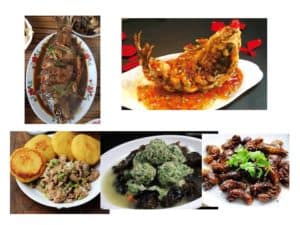
by cleowang | May 26, 2018 | FEATURE
Dear all,
Happy weekend! I’m back from China!
Today I’m presenting you with some yummy wild food:

The 2 fish dishes are from the delicious and auspicious fish in Chinese folk culture – carp! The first dish is red braised, the young farmer bought it fresh and live from market, and it was divine! The second dish is sweet sour deep fried carp, the bones become crispy, when that dish is served to us during Chinese New Year by my mum, it always disappeared in five seconds among the chopsticks of mine and my cousins’.
Picture3 is corn pikelets with prawn head paste, strong taste, typical local peasant’s food, today a delicacy sought by fancy eaters!
Picture 4 is Sheppard purse (wild herb) meatballs with woodear fungus.
Picture 5 is deep fried cicada in shell with sesame seeds and coriander! One favourite summer night activities by kids from old days and adults today is spotlighting cicadas in the dark, after they come out of soil, before they climb up the tree and shed the shells.
Why not come with me to Rural China this September (18th – 28th) to try some of these wonderful wild delicacies! Group size is limited to ensure great interaction and personable experiences, so please book in quick. If you’d like to secure a spot within next week, I’ll give you a free ticket to “Fish Kiss Bath” at Aishan Mineral Hot Spring. All you need to do to secure this special deal is to transfer $300 deposit to Shaoying Tours within next week, BSB 302 162 Account Number 1117866, with your name in the description, upon receipt of the deposit, Shaoying Tours will email an acknowledgement to confirm booking
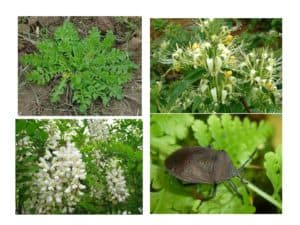
by cleowang | May 12, 2018 | FEATURE
After speaking at ACT Permaculture Festival and Australasian Permaculture Convergence, today I’d like to share with you ‘resourcefulness’ in rural China. Resourcefulness includes:
1.understanding the use of ‘weeds’ and ‘pests’, hence all resources
2. full use of nature’s resources, no wastage.
Resourcefulness comes from land knowledge and people’s respect of nature and its endowment.
Today I’m sharing with you the first aspect of ‘resourcefulness’: use of weeds and pests!
Below are some pictures of plants/animals that are our food and/or medicines, if we learn from villagers in rural China.

No. 1 plant is a common weed in gardens, road side, which is really delicious to eat and nutritious: shepard purse. You can tell them apart by their triangle seedpots, and its distinct taste once you get familiar with it. They are getting expensive in Chinese markets and restaurant.
No. 2 a very common garden plant/weed: honeysuckle. I know that the dried flower buds are very good for soothing sore throat, I did that last night for my sore throat, totally forgot about it today.
No. 3 I was corrected on the English name of this one by the beautiful permaculture guru: David Holmgren: it’s black locust! We eat the flowers in rural China, in all kinds of ways. The honey locust here have longer thorns, and we ate them too, I’m already your guinea pig.
No. 4 the famous Stink Bug! It has a beautiful name in Chinese medicine “Nine-fragrance bug”, once roasted for medicine. It’s the commoners’ inexpensive but effective medicine for removing energy and blood blockage in the body. I had to pay a bit money for it in Chinese medicine store in Sydney, I couldn’t tell the fragrance, but as long as it works.
I hope you’ve enjoyed the reading.
Please note that foraging needs timing and ways of treating plants, while I can be certain on some wild food, I’m not 100% on the other. Villagers are the ones to show you. One lady even picked an amanita-like mushroom in rural China (bright red with dots), told me how she treats them and eats them and they taste great.
Your tour to rural China will help people to realise what valuable knowledge they have and wake up the young to learn from the old and wise. The locals will give you so much knowledge, love, great food, domestic and wild.
By the way, if you haven’t liked Rural China Tour’s facebook page, please like it. Every like counts significantly! Thank you!
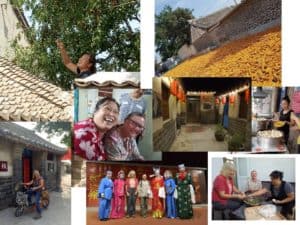
by cleowang | Apr 6, 2018 | FEATURE
One of Rural China Tours’ destinations – Xiheyang Ancient Village is on Chinese CCTV international channel, in a program called ‘Remember Homesickness’. The program talked about the international sailing skills of its villagers and the village-invented 10,000 ton aluminium presser that makes 60% of China’s Speed Train, And yes we visited that impressive factory. Pictures included.
We spent great few days with the villagers there, stayed in the ancient house converted accommodation. Please find the attached photos of accommodation and activities.href=”https://shaoyingtours.com/wp-content/uploads/2018/04/blog1-xiheyang.jpg”>
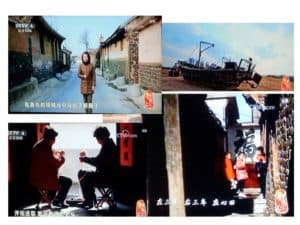
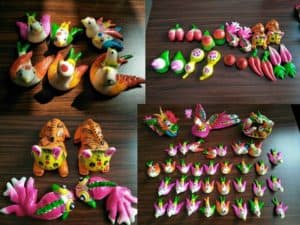
by cleowang | Mar 24, 2018 | FEATURE
Today I’m sharing about the little-known tradition in Jiaodong Peninsula (current rural China tour destination and my home region):
On the 3rd of March on lunar calendar, a newly-wed woman needs to give her mother and mother-in-law flour-sculpted swallows. This is for blessing her husband and fertility.
The 3rd of March is also called “Newly-Wed Woman Festival”.
In Chinese folk culture, swallows are symbols of diligence, and marriage harmony. In Jiaodong Peninsula, there’s a saying “it’s a worry when swallows don’t come to nest in one’s house”. Villagers know too well that swallows are auspicious birds. I’m so happy that my young friend, whom my tour guests met, has given her mum these beautiful cute swallows, together with many other auspicious plants and animals. I’ve learned something I didn’t know about my culture, here to share.

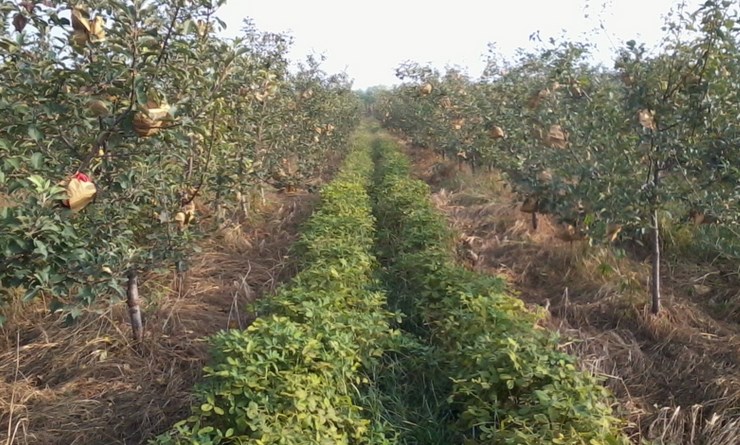
by cleowang | Feb 2, 2015 | Traditional Farming Practices
In comparison to large-scale monoculture, rural China inter plant crops according to their characteristics and the mutual benefits, here are peanuts planted between fruit trees.






